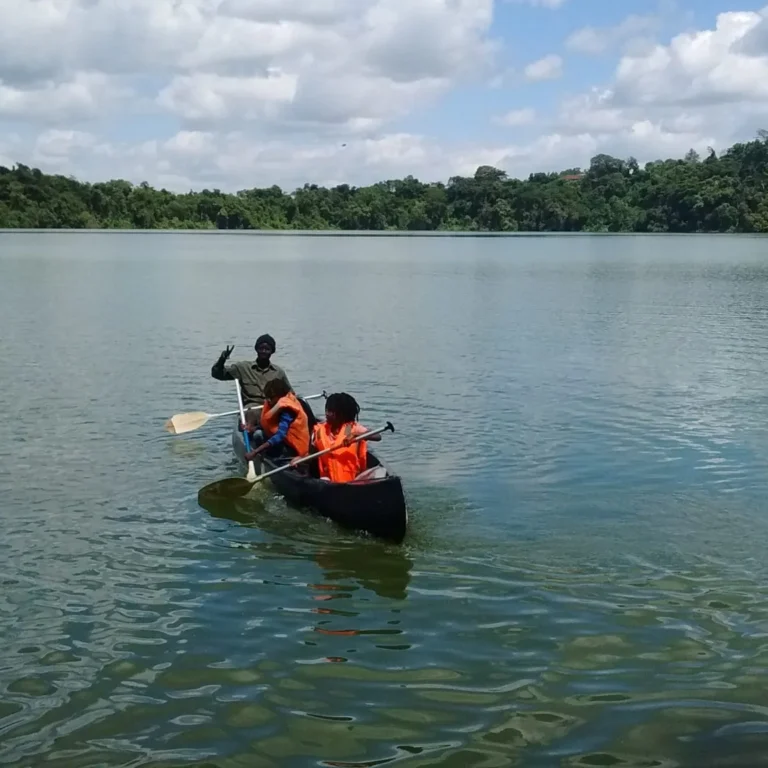10 Best Reasons To Visit Arusha National Park
The best reasons to visit Arusha National Park are its diverse activities, such as walking safaris, canoeing on the Momella Lakes, and guided hikes on Mount Meru. The park is known for its stunning scenery, including the Ngurdoto Crater, waterfalls, and views of Mount Kilimanjaro, while offering a peaceful safari experience with unique wildlife like black and white colobus monkeys. It is also an excellent destination for birdwatching, with over 400 species, and is easily accessible from Arusha city.
Nestled in the northeastern region of Tanzania, Arusha National Park is a hidden gem that offers a unique blend of landscapes, wildlife, and cultural experiences. This relatively small park, covering just 552 square kilometers, packs a punch with its diverse ecosystems, including lush forests, savannahs, lakes, and volcanic craters. Arusha is one of the most visited places for people heading out on Tanzanian safaris. The Arusha Airport has direct flights to Serengeti National Park. And many safaris head out to the other large national parks nearby such as Tarangire, Lake Manyara and Ngorongoro. Here are the top 10 best reasons to visit Arusha National Park, a destination that promises unforgettable adventures and breathtaking scenery.
1. Marvel at Mount Meru
Mount Meru, the second-highest peak in Tanzania, is a striking feature of Arusha National Park. Standing at 4,566 meters, this dormant stratovolcano offers a thrilling challenge for hikers and climbers. The trek to the summit is less crowded than the popular Mount Kilimanjaro. Providing a more intimate and serene climbing experience. Along the way, adventurers can enjoy diverse flora and fauna, stunning views, and a chance to see the crater’s inner workings.
2. Explore Diverse Ecosystems
Arusha National Park is a microcosm of Tanzania’s varied landscapes. Within its borders, visitors can find lush montane forests, open savannahs, swampy areas, and pristine lakes. This diversity supports a wide range of wildlife and plant species. Making it a fascinating destination for nature lovers and photographers alike.
3. Witness Abundant Wildlife
Despite its size, Arusha National Park is home to an impressive array of wildlife. The park is famous for its large populations of giraffes, often referred to as the park’s “trademark.” Visitors can also spot buffaloes, zebras, warthogs, and various antelope species. The park’s forests are inhabited by primates such as blue monkeys and black-and-white colobus monkeys. Bird enthusiasts will delight in the over 400 species of birds, including the vibrant flamingos that flock to the park’s Momella Lakes.
4. Discover Ngurdoto Crater
The Ngurdoto Crater, often compared to a miniature Ngorongoro Crater, is a volcanic caldera within the park. This lush, marshy crater is surrounded by steep cliffs and teeming with wildlife, including elephants, buffaloes, and a variety of bird species. The crater’s floor is off-limits to vehicles, ensuring that the wildlife remains undisturbed, but several viewpoints offer stunning vistas of this natural wonder.
5. Enjoy Canoeing on Momella Lakes
For a unique perspective of the park, visitors can go canoeing on the Momella Lakes. This peaceful activity allows for close encounters with waterbirds, hippos, and other aquatic creatures. The serene waters reflect the surrounding landscapes, creating perfect photo opportunities and a tranquil escape from the bustling savannahs.
6. Experience Cultural Tours
Arusha National Park is not only about natural beauty but also rich cultural heritage. Visitors can embark on cultural tours to nearby villages to learn about the traditions and lifestyles of the local Meru and Maasai communities. These tours often include visits to traditional homesteads, schools, and markets, providing an enriching cultural exchange and supporting community-based tourism.
7. Trek Through Lush Forests
The park’s lush montane forests are a hiker’s paradise. Trails wind through dense vegetation, past waterfalls, and up to scenic viewpoints. The forest is home to various bird species and primates, offering plenty of wildlife sightings along the way. The trails range from easy walks to more challenging hikes, catering to all levels of fitness and adventure.
8. Bird Watching Paradise
Arusha National Park is a bird watcher’s paradise with over 400 species recorded. The diverse habitats support a wide variety of birds, from the colorful turacos and troops to the majestic crowned eagles. The Momella Lakes are particularly popular for spotting flamingos, pelicans, and herons. Bird enthusiasts can spend hours exploring the park, ticking off sightings on their bird checklists.
9. Convenient Location
One of the significant advantages of Arusha National Park is its convenient location. The park is just a short drive from the city of Arusha, the gateway to the northern safari circuit. This proximity makes it an ideal destination for day trips or short excursions, allowing visitors to easily combine a visit to Arusha National Park with other famous attractions like the Serengeti and Ngorongoro Crater.
10. Ideal for Walking Safaris
Unlike many other parks in Tanzania, Arusha National Park offers the opportunity for walking safaris. Guided by experienced rangers, these safaris allow visitors to explore the park on foot, gaining a deeper connection with the environment and a chance to observe wildlife up close. Walking safaris are an exhilarating way to experience the park’s diverse landscapes and gain insights into its flora and fauna.
Interesting Facts About Arusha National Park
Arusha National Park, nestled in northeastern Tanzania, offers a unique blend of diverse ecosystems within its 552 square kilometers. The park boasts the stunning Mount Meru, Tanzania’s second-highest peak, providing thrilling climbing opportunities. It’s a haven for wildlife enthusiasts, featuring large populations of giraffes, buffaloes, zebras, and over 400 bird species, including vibrant flamingos at Momella Lakes. The lush Ngurdoto Crater and tranquil lakes offer breathtaking scenery. Arusha National Park’s proximity to Arusha city makes it an ideal destination for day trips. Unlike many parks, it allows walking safaris, providing an intimate wildlife experience. Cultural tours to nearby Maasai and Meru villages enrich visitors with local traditions and lifestyles.
Best Time to Visit Arusha National Park
The best time to visit Arusha National Park is during the dry season, from June to October, when wildlife is easier to spot as animals gather around water sources. The weather is mild and pleasant, ideal for hiking and walking safaris. For bird enthusiasts, the wet season from November to May is perfect, with migratory birds flocking to the park and the landscape lush and green. However, some roads might be challenging to navigate during heavy rains. Each season offers unique experiences, making Arusha National Park a year-round destination depending on your interests.
Wildlife and Landscape of Arusha National Park
Arusha National Park features a diverse landscape that includes lush montane forests, open savannahs, volcanic craters, and serene lakes. This variety supports a rich array of wildlife, such as giraffes, buffaloes, zebras, warthogs, and various antelope species. Primates like blue monkeys and black-and-white colobus monkeys inhabit the forested areas, while the Momella Lakes attract over 400 bird species, including vibrant flamingos. The park’s standout feature is Mount Meru, offering stunning vistas and challenging climbs. The Ngurdoto Crater, often likened to a mini Ngorongoro, teems with wildlife, providing spectacular viewing opportunities from its rim.
Where is Arusha National Park
Arusha National Park is located in northeastern Tanzania, near the city of Arusha. It lies between Mount Kilimanjaro and Mount Meru, encompassing 552 square kilometers of diverse landscapes. The park is easily accessible, just a short drive from Arusha city, which serves as the gateway to Tanzania’s northern safari circuit. Its convenient location makes it an ideal destination for day trips or as a starting point for exploring other renowned attractions such as the Serengeti, Ngorongoro Crater, and Mount Kilimanjaro. The park’s proximity to Kilimanjaro International Airport also adds to its accessibility for international visitors.
How Long from Arusha to Arusha National Park
Arusha National Park is conveniently located just 25 kilometers northeast of Arusha city. The drive from Arusha to the park typically takes about 45 minutes to one hour, depending on traffic and road conditions. This short distance makes the park an ideal destination for day trips, allowing visitors to easily explore its diverse landscapes and wildlife without extensive travel time. The proximity also enables a seamless transition for those continuing their safari adventures to other renowned destinations in Tanzania’s northern circuit.
How Long from Kilimanjaro Airport to Arusha National Park
Arusha National Park is approximately 35 kilometers from Kilimanjaro International Airport. The drive typically takes about one to one and a half hours, depending on traffic and road conditions. This convenient proximity allows travelers to quickly transition from their flight to exploring the park’s diverse landscapes and abundant wildlife. The short travel time makes Park an accessible and appealing destination for visitors flying into Tanzania, providing a perfect start to their safari adventures.
How to Get to Arusha National Park
Arusha National Park is easily accessible from both Arusha city and Kilimanjaro International Airport. From Arusha city, it’s a 45-minute to one-hour drive northeast. If arriving by air, the park is about an hour’s drive from Kilimanjaro International Airport. Visitors can hire a taxi, rent a car, or join a guided tour to reach the park. Many safari operators offer convenient transfers, ensuring a seamless journey to the park’s gates. The well-maintained roads make for a comfortable and straightforward trip, setting the stage for an unforgettable adventure in Tanzania.
Arusha National Park Travel Guide
Arusha National Park offers a compact yet diverse safari experience. Key attractions include Mount Meru, the lush Ngurdoto Crater, and the serene Momella Lakes. The best time to visit is during the dry season (June to October) for wildlife viewing, while the wet season (November to May) is ideal for bird watching. The park allows unique walking safaris and canoeing. It’s conveniently located near Arusha city and Kilimanjaro International Airport, making access easy. Accommodations range from luxury lodges to budget-friendly campsites. A visit provides rich wildlife encounters, stunning landscapes, and cultural experiences with local Maasai and Meru communities.
Stay Before or After Arusha National Park Safari
Before or after your Arusha National Park safari, consider staying in Arusha city for a range of accommodations, from luxury lodges to budget hotels. Popular options include Arusha Coffee Lodge for a blend of comfort and charm, and Mount Meru Hotel for its convenient location and amenities. Alternatively, enjoy the serene environment of Ngare Sero Mountain Lodge, located just outside the city. For a closer option, stay at Momella Wildlife Lodge within the park itself. These accommodations offer comfort and ease, enhancing your safari experience with convenient access to and from the park.
Weather, Climate, and Temperature of Arusha National Park Safari
Arusha National Park enjoys a temperate climate due to its elevation. Daytime temperatures range from 20°C to 25°C (68°F to 77°F), while nights can be cooler, especially at higher altitudes, dropping to around 10°C (50°F). The park experiences two main seasons: the dry season (June to October) with sunny, clear skies, and the wet season (November to May) featuring intermittent rain and lush landscapes. Rainfall is moderate, contributing to the park’s vibrant flora best reasons to visit Arusha National Park. The mild temperatures and varied climate make it a pleasant destination for wildlife viewing and outdoor activities year-round.
What to Pack for Arusha National Park
When visiting Arusha National Park, pack light, breathable clothing for daytime safaris and warmer layers for cooler evenings and higher altitudes. Essential items include a hat, sunglasses, sunscreen, and insect repellent. Comfortable hiking boots are recommended for walking safaris. Bring a camera with zoom lens for wildlife photography, and a pair of binoculars for bird watching. Don’t forget a reusable water bottle to stay hydrated, and a rain jacket during the wet season best reasons to visit Arusha National Park. A daypack for personal items and snacks will also enhance your safari experience.
How Safe is Arusha National Park
Arusha National Park is generally safe for visitors, with well-maintained facilities and experienced park rangers. Wildlife encounters are closely monitored to ensure safety, and guided tours are required for walking safaris. The park is free from predators like lions, which minimizes risk during hikes. However, it’s important to follow park rules and guidelines, respect wildlife, and be cautious of sudden weather changes. Ensure you’re well-prepared and travel with reputable tour operators or guides best reasons to visit Arusha National Park. Overall, Arusha National Park offers a secure and enjoyable experience for tourists.
How Many Days for Arusha National Park Safari
A typical visit to Arusha National Park can range from a half-day to two days, depending on your interests and itinerary. For a comprehensive experience, including wildlife viewing, hiking Mount Meru, and exploring the Ngurdoto Crater and Momella Lakes, a full day or overnight stay is ideal. This allows ample time for various activities, such as walking safaris and canoeing. If you’re combining your visit with other destinations, a half-day trip can be sufficient to enjoy the park’s highlights.
Top Things to Do in Arusha National Park
Top activities in Arusha National Park include climbing Mount Meru for stunning views and a challenging hike. Explore the Ngurdoto Crater, a lush caldera rich with wildlife. Enjoy canoeing on the scenic Momella Lakes, where you can spot flamingos and hippos. Take a walking safari to experience the park’s diverse landscapes up close. Visit the lush montane forests to see blue monkeys and black-and-white colobus monkeys. Don’t miss cultural tours to nearby Maasai and Meru villages for a unique local experience. Each activity offers a distinct way to experience the park’s natural beauty and wildlife.
Birding in Arusha National Park
Arusha National Park is a bird watcher’s paradise with over 400 species recorded. The diverse habitats, including montane forests, savannahs, and lakes, attract a wide variety of birds. Highlights include the vibrant turacos, trogons, and the majestic crowned eagles. The Momella Lakes are ideal for spotting waterbirds like flamingos, pelicans, and herons. The park’s mix of resident and migratory species offers year-round birding opportunities. Guided birding tours enhance the experience, providing expert knowledge and helping to identify the many species found within the park.
Conclusion: Best Reasons To Visit Arusha National Park
Arusha National Park may be one of Tanzania’s smaller parks, but it is undoubtedly one of the most diverse and accessible. Whether you’re an avid hiker, a wildlife enthusiast, or someone looking to immerse yourself in local culture, Arusha National Park offers something for everyone. Plan your visit today and discover the myriad wonders that await in this enchanting corner of Tanzania.








